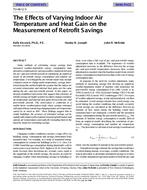
TO-98-12-5 — The Effects of Varying Indoor Air Temperature and Heat Gain on the Measurement of Retrofit Savings
Many methods of estimating energy savings from measured weather-dependent energy consumption data attempt to compensate for varying weather conditions between the pre- and post-retrofit periods by identifying an empirical model of pre-retrofit energy consumption and outdoor air temperature. Even though the pre-retrofit model may include a balance-point or change-point temperature, savings determined using this method implicitly assume that the indoor air set-point temperature and internal heat gains are the same during the pre- and post-retrofit periods. In this paper, we develop simplified expressions that suggest that estimates of retrofit savings are highly sensitive to minor changes in indoor air temperature and internal heat gains between the pre- and post-retrofit periods. This observation is confirmed in a mobile-home weatherization study where savings estimated with and without considering changing indoor air temperature varied by as much as 89%. These findings suggest that in simple buildings, the accuracy of estimated savings can be significantly improved by routinely measuring both indoor and outside air temperatures and explicitly including them in the baseline model for estimating savings.
Units: Dual
Citation: Symposium, ASHRAE Transactions, 1998, Vol. 104, Part 2, Toronto, ON
Product Details
- Published:
- 1998
- Number of Pages:
- 6
- File Size:
- 1 file , 120 KB
- Product Code(s):
- D-7729


